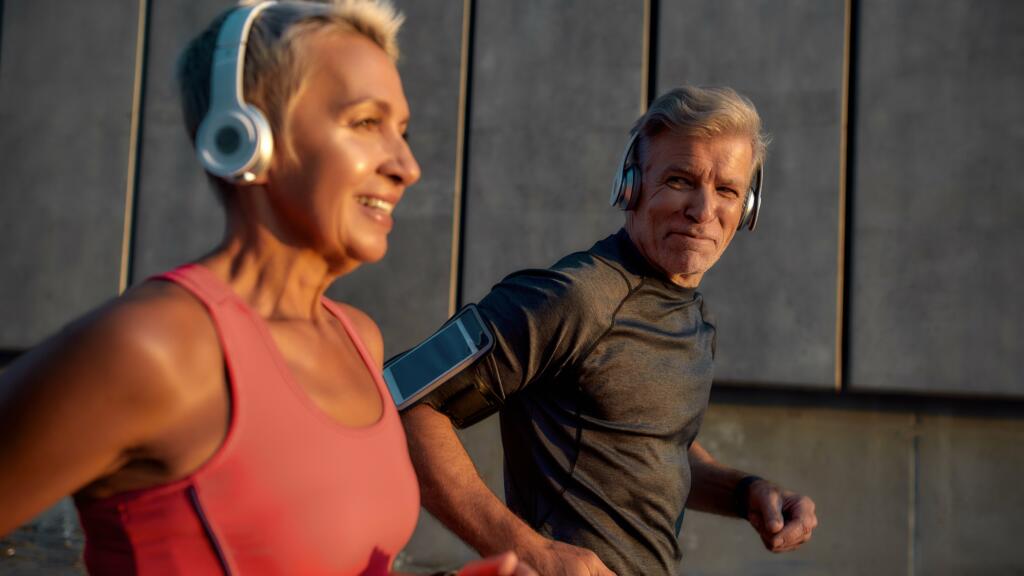
12 stretches to try right now
Becky Fuller
Can press-ups really make you run faster?
Running is a fantastic and highly enjoyable form of exercise. Whether you jog a couple of miles twice a week, or you regularly tackle marathons, running is an excellent way to keep fit and healthy.
If you’ve been running for a while and feel as if you’re stuck on the same distance and time, there are ways to make a difference.
You can vary your route, for one, and try a different terrain – either will make your body work in a different way than it’s used to.
Adding more hills, for example, or running through woodland rather than a flat pavement can help build more power in the front of your legs or improve running dexterity.
But while variation is a wonderful thing, it doesn’t help much if you’re looking to get faster, more powerful, or wanting to take on longer distances.
For that, you need strength training.
Running is a fantastic and highly enjoyable form of exercise. Whether you jog a couple of miles twice a week, or you regularly tackle marathons, running is an excellent way to keep fit and healthy.
If you’ve been running for a while and feel as if you’re stuck on the same distance and time, there are ways to make a difference.
You can vary your route, for one, and try a different terrain – either will make your body work in a different way than it’s used to.
Adding more hills, for example, or running through woodland rather than a flat pavement can help build more power in the front of your legs or improve running dexterity.
But while variation is a wonderful thing, it doesn’t help much if you’re looking to get faster, more powerful, or wanting to take on longer distances.
For that, you need strength training.
 Credit: Shutterstock / BAZA Production
Credit: Shutterstock / BAZA ProductionThe words strength training might conjure up images of Olympic weightlifters, or some kind of strong man competition. The reality is that strength training takes many different forms.
You might have heard of resistance training, and that’s the same thing. In short, strength or resistance training uses an opposing force against your body to make your muscles stronger.
That could take the form of lifting weights in a gym but equally, it may mean using resistance bands or dumbbells in your own home.
Your own body can also offer resistance; bodyweight squats or push-ups can really help build muscle.
The benefits of strength training are enormous, and it’s something that everyone can try and incorporate into their exercise plan. Not only does it improve fitness and health, it also builds stronger bones, protects against osteoporosis and osteoarthritis, and preserves muscle mass, which can decline as we age. When it comes to running, adding resistance training can really make a difference.
 Credit: Shutterstock / pikselstock
Credit: Shutterstock / pikselstockStrength training aids running in three fundamental ways.
“Studies in the British Journal of Sports Medicine have shown that strength training exercises improve running economy,” Emma Goodman, personal trainer (PT) at Bio-Synergy tells Exceptional.
Mollie Millington, The Happiness Personal Trainer, adds: “An exercise like running as a movement uses your entire body, not just your legs. So, strength training is key to staying fit and remaining injury-free as a runner.”
Being a regular runner puts you at risk of injury owing to repeated pressure on knee, ankle, and hip joints. Few of us have the perfect running gait, but strength training can help correct postural issues and muscle imbalances.
Speaking to Exceptional, Dean Zweck, product development manager at Total Fitness, says: “A lot of running injuries stem from a lack of muscle strength. This can include injuries such as runner’s knee, pain caused by abnormal movement of the kneecap and Achilles tendonitis (strain to the tendon of the calf).”
He adds: “Nobody likes to be injured, least of all runners – and increasing strength in your core, glutes, hips and ankles stabilises your muscles and decreases your risk of injury.”
If you feel you have a hip issue, or you roll your ankle easily when running, it’s worth contacting a physio for advice. They can recommend exercises that will help strengthen those specific joints.
“Hamstrings and glutes keep your legs turning over and create injury if they are too imbalanced in terms of strength,” says Millington. “Videotape yourself running and see how far your heels lift off the ground. Premier athletes will bring their heels up to their bums because they are strong.”
You can also visit many running stores to have your running gait analysed, which can help you to pick up anything that needs specific work.
Strength training is proven to make joints stronger, and the stronger they are, the better your body will work – just as a car that is regularly serviced and well-maintained works better than one left to rust.
Training correctly for running makes muscles more powerful. The bigger the muscles, the more effective they will be during your runs. Developing muscular endurance – how long your muscles can keep moving for – will help if you’re a long-distance runner.
“Stronger muscles allow you to run faster,” Zweck says. “If you look at the body shape of sprinters and athletes, you don’t need huge muscles to run fast, but stronger muscles can produce more power, and more power means more speed.”
 Credit: Shutterstock / Dragon Images
Credit: Shutterstock / Dragon Images When it comes to improving speed and power, the type of resistance training you do is important. If you already run regularly, your cardio needs are covered.
You don’t need to be taking part in high-intensity interval training (HIIT) sessions, circuit training classes, or CrossFit.
Intense sessions like these that mix cardio and weights will come at a detriment to your running ability. Not only is injury more likely, but you’re not giving your body a chance to recover fully from the cardio efforts running involves. If you’re focused on improving power, then you need to be looking at a slower, more effective way of training.
“To optimise strength training, runners should allow more than three hours of recovery time between running and resistance sessions, and 24 hours’ recovery after strength training before a high intensity running session,” Goodman advises.
When it comes to improving running, there’s no need for endless lifting sessions, or hours spent in the gym. Again, this will lead to fatigue when you try and combine it with your run schedule and, far from enhancing your performance, you’ll be causing it to suffer.
Instead, focus on compound movements – ones that use lots of big muscles in the body at once – to give you more bang for your buck, as they say.
Take a whole-body approach, and focus on moves that build power, such as squats (slow to lower down under load, and then a big powerful drive back up), or kettlebell swings (strong, snappy hip drive and glute contraction).
 Credit: Shutterstock / Anatoliy Karlyuk
Credit: Shutterstock / Anatoliy KarlyukObviously, any running-specific strength programme will need to include leg work. The biggest muscles in the body are in the lower half, and the good news is they like to be worked in synergy with one another, reinforcing the earlier point about including compound movements.
“Examples of strength exercises could include barbell squats, deadlifts, step-ups, lunges and calf raises,” says Goodman. “Lift loads or weights at 60-80% of one-rep max, or the heaviest weight that can be lifted with maximum effort in a single rep, for three to six sets of 5-15 reps.”
These exercises all use the big muscles in the legs and glutes in one go and really help develop strength. Including single-sided work, such as single leg Romanian deadlifts, or split squats will help correct any imbalances or weaknesses on one side.
“If you like trail running, including hip, abductor and adductor movements will prepare your body for side-to-side motions,” Millington says. “You also need to keep your ankles strong for uneven surfaces.”
Adding simple ankle mobility drills into your routine will benefit the joints and help with body weight distribution when running. This video from E3 Rehab features some useful exercises.
“I personally like ‘ice skater’ exercise,” says Zweck. “This is where you bound side to side from one leg to the other. If you want to add further resistance, try to incorporate a light dumbbell. A stair climber at your gym will help strengthen your legs and will make running up hill feel a lot easier.”
 Credit: Shutterstock / YAKOBCHUK VIACHESLAV
Credit: Shutterstock / YAKOBCHUK VIACHESLAV“Having a strong core will help you keep upright,” says Millington. That doesn’t mean you need to have a perfectly defined upper body, but it does require paying attention to these important stabiliser muscles.
When running, it’s easy to fall into a posture that feels comfortable. But that might not mean it’s correct, and what’s worse, however comfortable it feels, it could lead to problems further down the line.
Your core muscles aren’t just your abs, either. The core includes the glutes and muscles of the lower back. The stronger and more effective these are, the less likely you are to develop back issues.
A lot of strength training, such as deadlifts and squats, will automatically make your core work. But as an addition, moves such as planks and glute bridges will help build core strength.
 Credit: Shutterstock / MDV Edwards
Credit: Shutterstock / MDV EdwardsA balanced body is a healthy body, and one which will prove much more efficient at running. Don’t forget, we need our arms to help drive us forward – the power they generate flows through the kinetic chain – an engineering term for the chain of energy created by our joints – and you might notice you use your arms even more when you’re tired.
So, the upper body needs to be included when we’re adding strength training to our regime.
“Exercises like chest press, lat pulldowns and shoulder press target most of the muscles in your upper body, allowing you to remain strong and maintain balance between your upper and lower body,” Zweck advises.
Pull-ups are also fantastic for both upper body and core – provided you do them correctly.
 Credit: Shutterstock / PAstudio
Credit: Shutterstock / PAstudioThere are many options for adding strength training to your plan. You might like to join your local gym and use the equipment there. If you do, make sure you have a full induction with a member of staff who can show you how everything works so you’re exercising safely. Many gyms will offer a programme for you to follow.
“Depending on an individual’s goals and training ability, the weight, sets, reps and recovery can be adjusted,” says Goodman. “And if in doubt ask an exercise professional such as a qualified PT for advice.”
There’s also the option of home workouts, which might mean buying some equipment, such as dumbbells or a bench. There’s a wealth of exercise apps and videos out there. Millington recommends one that includes a variety of exercises.
“There is an app called Run Less, Run Faster that focuses more on cross-training sessions than time on your feet. It includes yoga and stretching, along with weights, cycling and swimming to get your body ready for race day.”
 Credit: Shutterstock / Cameron Prins
Credit: Shutterstock / Cameron PrinsZweck has some great advice for anyone already working on a solid running schedule
 Credit: Exceptional
Credit: ExceptionalIf you’re still wondering whether strength training is worth it, we spoke with Kath, a member of our experienced voices panel. I have had the pleasure of training Kath for three years now and watching her progress both in her strength work and as a runner, has been a joy.
“I’ve been running on and off since 2003, when I had a crazy idea of running a marathon. Since then, there have been times when I have done strength work alongside the running, and times when I haven’t,” she says. “What I’ve noticed is that running is great, but I lose motivation when I don’t see much change in speed or stamina or the distance I can do.
“Mixing it up with strength training has helped to keep me motivated, but has also resulted in my running speeds increasing, without me even noticing. It’s a very nice surprise when you see the stats at the end of a run.
“I also find having a stronger core has helped stop me stooping forward, which used to cause back pain especially on longer runs as my legs start to tire.”
She adds: “I do think I have fewer injuries because of building and working on strength alongside my running. My knees and hips are pretty good for their age!”

Written by Becky Fuller she/her
Published:
Becky Fuller is a fully qualified Personal Trainer, specialising in strength and conditioning for over 50s. Becky’s focus is helping people to become stronger both in body and mind, and to move well without pain. Becky also has many years’ experience working as a freelance journalist, writing for a wide variety of publications such as Screen Rant, Geek Feed, and Daily Actor. She also regularly reviews theatre productions for UKTW.